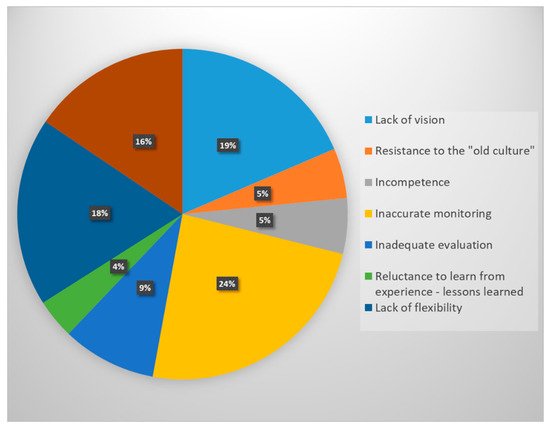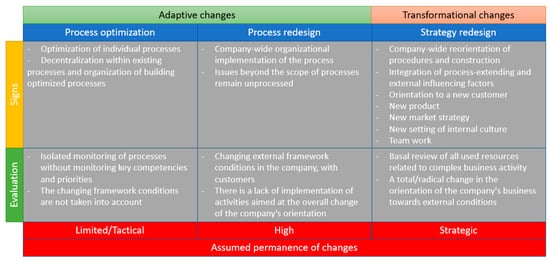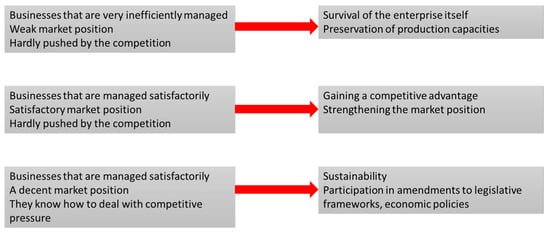You're using an outdated browser. Please upgrade to a modern browser for the best experience.
Please note this is an old version of this entry, which may differ significantly from the current revision.
Subjects:
Engineering, Manufacturing
In the pursuit of economic survival in the current competitive conditions with the aim of long-term prosperity and sustainability in the market, many companies today approach significant strategic changes in the management of their business. The design of a systematic procedure for implementing strategy changes into internal business processes for a project-oriented production type of organization is of importance.
- advanced industrial engineering
- strategy
- management
- business processes
- business performanc
1. Introduction
Due to the constant growth of input costs (personnel costs, energy, input materials, etc.), many Slovak companies have found themselves in this difficult position, having to wage tough competitive battles both on domestic and global markets. Competitive advantage can be created by free disposable capital, a traditional position on the market, or long-term management experience; above all, you need the ability to use radical innovation of internal processes, tools for managing these processes, and online monitoring of selected parameters as a very effective weapon.
The key to success is not the micro-management of individual operations, but focusing on the main internal processes in the company in such a way that improvements can be achieved in terms of critical weight of performance; these include costs, quality, services, deadline fulfilment, and above all, orientation to the customer and their problems and the challenges it encounters in the implementation of its business models.
The company’s strategy guides all management decisions from the front line. Strategic plans act as a road map that helps businesses achieve the big vision of their owners and top managers in practical ways. A change in an organization’s strategy can change the way an organization operates, changing everything from the organizational structure to the daily routines of employees. When changing the strategy, it is vitally important to realize the individual correlations between the sub-strategies themselves and the internal processes. Not all effects of change are positive. Internal employee resistance can be a ma-jor obstacle to effective change implementation, as some people strongly resist any kind of change to the status quo or daily routine. There is also always the possibility of failure in new initiatives, leaving the company in a worse position than it was before the change.
Fundamental factors that fatally affect the success of implementing strategy changes into internal company processes have been identified. A survey of 100 manufacturing companies in the Slovak Republic revealed the following factors (Figure 1).

Figure 1. The fundamental factors that fatally affect the success of implementing strategy changes into internal company processes.
A project-oriented production organization that pursues a single goal, namely the successful implementation of individual projects in terms of costs, meeting deadlines, covering overheads, and of course, expected profitability. With the successful implementation of individual projects and the non-exceeding of individual budgets in the administration departments, the continuous fulfilment of the relevant business plan of the company in the relevant year is also guaranteed. The preparation process of internal process changes in view of the company’s changing strategy consists of several parts that are essentially independent, but mutually connected (see Figure 2).

Figure 2. The relationship between strategic plan changes and process change.
A change in a strategic plan is a change that is based on the results of strategic planning, and forecasting is a result of technical forecasts. In this process, the healthy core of the company must be used as a basis for achieving set goals, supporting strategy creation, and defining priority changes in internal processes. The process of changing internal processes due to changes in the company’s strategy is divided into two phases: design of changes (concept, plan); and implementation of changes. The proposal is the beginning of the change process and contains the position of the project in the company, value indicators, and also all managerial, operational, social and technological changes. Implementation is a process in which we develop plans for internal process changes that are gradually implemented, and at the same time they are monitored, evaluated and corrected with appropriate measures.
2. Background
Digital transformation reveals new ways for an organization to stay in touch with customers and consumers and thus create value for them [1]. Most consumers behave subconsciously or unconsciously [2]. Marketers try to understand how individual features of a product contribute to the overall evaluation [3].
Today, most authors and managers consider strategic management to be a complex, internally structured, and continuous process [4,5]. A simple model of strategic management was presented in his work by [6] considering the continuity of the basic phases. It is possible to state that strategic management is an iterative process, gradually passing through individual phases and their steps; a process that is constantly and continuously ongoing. Automotive and component manufacturing companies form a tandem of recognized prestige in terms of competitiveness and results [7].
Strategic management integrates multiple procedures and analyses which evaluate the organization’s results and adapts them to changes in the external environment. It is a relatively complex process that involves several managers in the organization and affects the actions of all employees [6]. The rapid progression of globalisation has driven companies to search for new approaches to improve their performance by producing products at a much lower cost, timelier and with superior quality [8].
The identification of research gaps from systematic reviews is essential to the practice. It is important to address that business process management will continue to be a crucial tool for any organization that is trying to improve its operations. New technologies will emerge providing new opportunities to obtain automational effects, informational effects, and transformational effects. The key question is: “How will digitisation change jobs and work profiles?” The authors of [9] claim their analysis as follows: The extent of computerisation in the twenty-first century will thus partly depend on innovative approaches to task restructuring. Restructuring tasks, and more broadly operations, are exactly what BPM is concerned with [10] in his study, concluding that business process management is developing a stronger strategical perspective which has the potential to support digital strategies of customer engagement and digitized solutions.
Figure 3 below describes the steps of the strategic management process as a continuous process.

Figure 3. Steps of strategic management.
The first step of strategic management is the formulation of the strategic intent. It primarily contains the determination of the business vision and mission of the organization, and based on them the long-term strategic goals of the organization are established. Briefly, the vision of the company can be characterized as a time-bound description of the form into which the company wants to transform at the end of the planned period. The vision represents an attractive picture of the company in the distant future. The mission is then a time-bound formulation of the company’s future focus, while the mission primarily answers the questions “Who are we?”, “Why do we exist?”, or “What is the basic meaning of our existence?”. The answers to these questions create the basic values of the organization. The strategic goals of the organization should be based on the already established vision and mission of the company. Strategic goals define the end state towards which the organization’s vision is directed. Their purpose is to define a measurable outcome of the vision. Part of this step is the analytical phase, i.e., a detailed analysis of the internal and external environment of the organization [11].
The analysis of the internal environment of the organization aims to identify the strengths and weaknesses of the organization in relation to the established strategic goals, vision and mission of the organization. The purpose is also to identify key competencies and key vulnerabilities of the organization [12,13,14].
The analysis of the external environment focuses on identifying those opportunities and threats of the external environment that could affect (positively or negatively) the achievement of the set strategic goals. There is a relatively wide range of tools for analyzing the internal as well as the external environment [15].
The last part of the formulation of the strategic intention is the so-called strategic synthesis, for which a SWOT analysis is normally used and serves to determine the strategic position of the organization.
The second step of strategic management is the creation of the strategic plan itself. Based on the performed SWOT analysis [16,17,18,19,20] variants of the strategy are determined, and subsequently the selection of a suitable variant of the strategy is based on the synthesis of information from the internal environment of the organization as well as from the analysis of the external environment. After choosing a suitable variant of the strategy, the results are balanced with the original ideas about the vision of the company, its mission or established strategic goals. If the results of the analysis proved that the originally intended vision and strategic goals are unrealistic (oversized or undersized), it is necessary to adapt the vision and strategic goals to these results. Subsequently, it is necessary to specify the strategy for different levels of the organization. For all strategies, it is expedient to create an implementation plan according to the chosen management method, such as BSC, and EFQM. The result of this step is a detailed strategic plan for the organization [21].
The Balanced Scorecard (BSC), a strategic performance-management tool that brought strategy and clarified major organizational objectives for companies’ agendas [22], significantly contributed to this process. Many leading companies began to adopt the BSC when they found that it allowed them to improve performance, linking all organization members in a joint effort to achieve the organization’s overall goals and objectives [6,7,8,9]. The ability to achieve ambitious goals depends, as such, on organizational capabilities for learning and growth [23,24,25,26,27].
The third step of strategic management is the implementation of the strategic plan in the day-to-day activities of the organization. In this step, the strategic plan is elaborated into tactical and operational plans which affect the day-to-day activities of the organization and all management functions are subordinate to them—planning, organizing, leading and controlling.
The fourth step of strategic management is strategic control, which enters the process of strategic management. Each of its steps allows measuring the ongoing results of the entire process and correcting individual steps. At the same time, it brings continuity to the entire process and makes strategic planning a never-ending process.
The Management of Change
The driving force behind changing a company’s strategy is always the desire to move the company to a higher level or improve its economic results. An important factor is to realize that a change in internal processes caused by a change in strategy is always a relatively large intervention in the internal functioning of any company. Therefore, it is necessary to focus on a correct and meaningful awareness of what changes need to be made and how to understand these changes in the wider context of all processes in the company.
Categorization of changes in internal processes caused by a change in the company’s strategy is a process in which changes can be divided into three basic groups (see Figure 4) according to the severity of the influence of depth on process redesign or adjusting the strategy.

Figure 4. Essential distribution of changes according to the severity of the impact of process changes.
Change management is influenced by resource settings and the selection of key performance indicators (KPIs) [28]. Companies process volumes of data, looking for suitable indicators so that they can make decisions and manage the company’s internal processes. It is a process of guiding organizational change to implementation, from the earliest stages of conception and preparation, through implementation and finally to resolution. Change processes have a set of initial conditions and a functional endpoint. The process in between is dynamic and takes place in stages.
From the point of view of company performance companies monitor financial performance indicators, and the most common indicators that are implemented in IS or are provided within management information systems (MIS) are:
-
Evaluation of the management result through the income statement, or balance sheets;
-
Indicators resulting from the company’s financial statements;
-
Activity indicators: inventory turnover time, debt collection time, liability maturity date, total asset turnover;
-
Liquidity indicators: immediate liquidity, current liquidity, total liquidity;
-
Indebtedness indicators: total indebtedness, self-financing coefficient, credit indebtedness;
-
Profitability indicators: profitability of total assets (ROA), the profitability of equity (ROE), the profitability of sales, the profitability of costs, return on investment (ROI);
-
Market value indicators: profit per share, dividend yield;
-
Cost indicators: total cost, personal cost.
To the most used indicators from the point of view of the owners, e.g., belong to:
-
Economic value added—EVA (Economic Value Added);
-
Value added by the market—MVA (Market Value Added);
-
Added value for shareholders—SVA (Shareholder Value Added);
-
Profitability of net assets—RONA (Return of Net Assets) and others.
Based on the study [33] the challenge for any company is to identify the most relevant model that can be adapted to the contexts of the business.
3. The Impact of Strategy Change on Business Process Management
Modern business organizations face dynamic changes in their management environments, and many firms actively consider adopting information technology (IT) to adapt to these changes [34]. Every company management in this hectic time faces the challenge of maintaining stability and achieving a certain level of predictability of the company’s performance [35,36,37,38,39]. To meet new challenges and business interests organizations must constantly monitor, evaluate and adjust their strategic initiatives. When a new strategy needs to be implemented [40], it is usually up to managers to ensure its successful implementation. Information on how to successfully implement strategic change into processes usually contains several step-by-step procedures that are very general.
The subject of the investigation was the realization of how the change affects the strategy and internal processes of the organization. This is done by describing what change is, discussing categories of change, external drivers of change, and perceptions of change initiatives as negative or positive [30,31]. The consequences of changes in strategy can take many forms: for example, it brings different challenges to different people depending on their position in the organizational hierarchy.
Research on the impact of strategy changes has shown that strategy change is a process that relates to the overarching goals and objectives of a business. Strategic decisions influence which business area the company operates in and for whom it benefits. It is also important how the company functions internally and what factors influence changes in the internal process (Table 1). It is very difficult to predict exactly what will happen when an organization changes its strategy, but companies experience several common positive and negative effects when they undergo a strategic transformation.
Table 1. Factors affecting/not affecting the success of internal process change.
| Factors Affecting the Success of Internal Process Change: | Factors Not Affecting the Success of Internal Process Change: |
|---|---|
|
|
Based on the research, we can assume that the problem of reaction to the external environment does not lie in external factors but is rather related to how the management of the company can process these factors, especially if the external environment is constantly changing and dynamic.
Each input for the needs of strategy change is generally based on three aspects of Figure 5, which form a strong stimulus for changing the corporate strategy in the context of changing internal company processes.

Figure 5. The status of the enterprise and the target state of the change.
This entry is adapted from the peer-reviewed paper 10.3390/su141711112
This entry is offline, you can click here to edit this entry!
